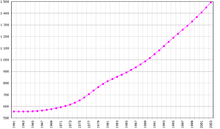- Demographics of Guinea-Bissau
-
This article is about the demographic features of the population of Guinea-Bissau, including population density, ethnicity, education level, health of the populace, economic status, religious affiliations and other aspects of the population.
The population of Guinea-Bissau is ethnically diverse with distinct languages, customs, and social structures. Most Guineans, 99%, are blacks — mostly Fula and Mandinka-speakers concentrated in the north and northeast, the Balanta and Papel, living in the southern coastal regions, and the Manjaco and Mancanha, occupying the central and northern coastal areas. Most of the rest are mestiços of mixed Portuguese and black descent, including Cape Verdean minority. Due to the exodus of most Portuguese settlers after independence, less than 1% of Guinea-Bissauans are pure Portuguese. The country also has a Chinese minority, including Macanese people of mixed Portuguese and Chinese blood from Macau. Most people are farmers. 50% are Muslims — this makes Guinea-Bissau the only Portuguese-speaking nation with a Muslim majority and most Muslims are Sunnites; 40% are pagans, principally Fula and Mandinka. Less than 10% are Christians, mostly Roman Catholics.
CIA World Factbook demographic statistics
The following demographic statistics are from the CIA World Factbook, unless otherwise indicated.
Population: 1,596,677 (July 2011 est.)
Age structure:
0-14 years: 40.4% (male 321,889; female 323,202)
15-64 years: 56.4% (male 435,986; female 465,117)
65 years and over: 3.2% (male 19,975; female 30,508) (2011 est.)Population growth rate: 1.988% (2011 est.)
Birth rate: 35.15 births/1,000 population (2011 est.)
Death rate: 15.27 deaths/1,000 population (2011 est.)
Net migration rate: 0 migrant(s)/1,000 population (2011 est.)
Sex ratio:
at birth: 1.03 male(s)/female
under 15 years: 1 male(s)/female
15-64 years: 0.9 male(s)/female
65 years and over: 0.83 male(s)/female
total population: 0.94 male(s)/female (2000 est.)Infant mortality rate: 96.23 deaths/1,000 live births (2011 est.)
Life expectancy at birth:
total population: 49.04 years
male: 46.77 years
female: 51.37 years (2000 est.)Total fertility rate: 4.51 children born/woman (2011 est.)
Nationality:
noun: Guinean (s)
adjective: GuineanEthnic groups: African 99% (Balanta 30%, Fula 20%, Manjaca 14%, Mandinga 13%, Papel 7%), European (entirely Portuguese) and Mulatto less than 1%
Religions: Muslim 50%, indigenous beliefs 40%, Christian 10% (see Religion in Guinea-Bissau)
Languages: Portuguese (official), Crioulo, African languages
Literacy:
definition: age 15 and over can read and write
total population: 42.4%
male: 58.1%
female: 27.4% (2003 est.)Guinea-Bissau Politics President · Prime Minister · Parliament · Elections · Political parties · Military · Coat of arms · Human rights · Foreign relationsHistory Regional history · Kaabu · African slave trade · Portuguese Guinea · War of Independence · PAIGC · Civil War · UNOGBIS · 2010 military unrestGeography Economy Society Outline · Index · Portal Demographics of Africa Sovereign
states- Algeria
- Angola
- Benin
- Botswana
- Burkina Faso
- Burundi
- Cameroon
- Cape Verde
- Central African Republic
- Chad
- Comoros
- Democratic Republic of the Congo
- Republic of the Congo
- Côte d'Ivoire (Ivory Coast)
- Djibouti
- Egypt
- Equatorial Guinea
- Eritrea
- Ethiopia
- Gabon
- The Gambia
- Ghana
- Guinea
- Guinea-Bissau
- Kenya
- Lesotho
- Liberia
- Libya
- Madagascar
- Malawi
- Mali
- Mauritania
- Mauritius
- Morocco
- Mozambique
- Namibia
- Niger
- Nigeria
- Rwanda
- São Tomé and Príncipe
- Senegal
- Seychelles
- Sierra Leone
- Somalia
- South Africa
- South Sudan
- Sudan
- Swaziland
- Tanzania
- Togo
- Tunisia
- Uganda
- Zambia
- Zimbabwe
States with limited
recognition- Sahrawi Arab Democratic Republic
- Somaliland
Dependencies and
other territories- Canary Islands / Ceuta / Melilla / Plazas de soberanía (Spain)
- Madeira (Portugal)
- Mayotte / Réunion (France)
- Saint Helena / Ascension Island / Tristan da Cunha (United Kingdom)
- Western Sahara
Categories:- Islands of Guinea-Bissau
- Demographics by country
- Guinea-Bissauan society
Wikimedia Foundation. 2010.


